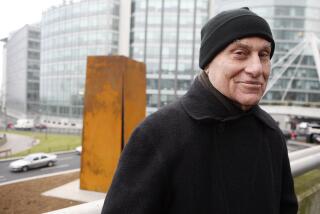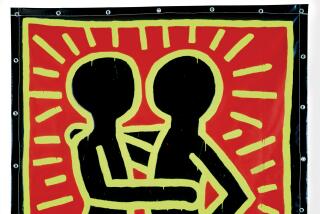Keith Haring; Subway Pop Graffiti Artist
NEW YORK — Keith Haring, whose distinctive, cartoon-like drawings in subway stations caught the attention of art dealers who made him famous miles away from those dank underground tunnels, died Friday of AIDS. He was 31.
Haring, who was diagnosed as having AIDS more than a year ago and was active in AIDS fund-raising, fell ill with flu-like symptoms in January and died early Friday at his Manhattan home.
Haring’s work, characterized by cartoon-like human and animal figures in an energized setting, has appeared in murals in settings as diverse as the Berlin Wall and a Monte Carlo hospital.
He has had 42 one-man shows and his paintings and drawings sell for tens of thousands of dollars.
The Whitney Museum of American Art was preparing a one-man show of his work at his death.
But his critical reputation never matched his popularity. Critics cited what they said was a lack of focus.
Newsweek’s Mark Stevens once called Haring’s work “fast food. . . . It’s a good time. It’s boogieing on Saturday night. But great--no.”
Others resented the commercialization of his art through T-shirts and posters. But to Haring, that was part of his point.
“If commercialization is putting my art on a shirt so that a kid who can’t afford a $30,000 painting can buy one, then I’m all for it,” Haring said. “Art is nothing if you don’t reach every segment of the people.”
A native of Kutztown, Pa., Haring began drawing at age 4, imitating cartoon figures of animals drawn by his father. He briefly attended a commercial art school in Pittsburgh, then enrolled at the School for Visual Arts in New York at 20.
He was immediately attracted to subway graffiti, which he referred to as movable art, “paintings that traveled to you instead of vice versa.”
He was arrested many times in the course of making thousands of subway drawings. Sometimes he received $10 fines and other times he was jailed briefly. A puckish personality, he soon became a familiar figure to many New York police officers and some of them became fans of his art.
His motifs included glowing babies, dancing figures, pyramids, creatures with TV heads, and barking dogs.
By 1983, Artnews was calling his work “provocative, far-reaching and uplifting.”
His work soon found its way into the art galleries of Manhattan’s SoHo gallery district as well as Los Angeles, London, Amsterdam and Sydney. Then it was hung in museum shows and collections. At the 1983 Whitney Museum biennial, which showcases avant-garde talent, he was represented by graffiti on an 18-foot wall.
Among his best-known works was a 300-foot mural he painted on the Berlin Wall in 1986, a chain of red and black human figures on a yellow background--incorporating the colors of the flags of East and West Germany.
Other murals include those at Children’s Hospital in Washington, Grady Hospital in Atlanta, Necker Children’s Hospital in Paris and the maternity ward of Princess Grace Hospital in Monte Carlo.
He did a great deal of work for free, including posters for the anti-apartheid movement, anti-crack murals and the logo for the Great Peace March, as well as a logo for National Coming Out Day, a campaign for greater gay and lesbian visibility.
In 1986, Haring opened the Pop Shop in New York to sell products bearing his art--T-shirts, refrigerator magnets and inflatable toys, among other items.
During the 1980s, he was a part of New York’s highly visible art community, partying with rock star Grace Jones, Boy George, Brooke Shields and Andy Warhol, his mentor.
Even after his illness was diagnosed, Haring continued drawing, painting and creating art for his business and the public.
More to Read
The biggest entertainment stories
Get our big stories about Hollywood, film, television, music, arts, culture and more right in your inbox as soon as they publish.
You may occasionally receive promotional content from the Los Angeles Times.










